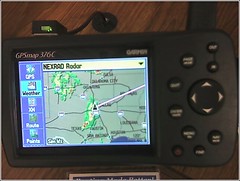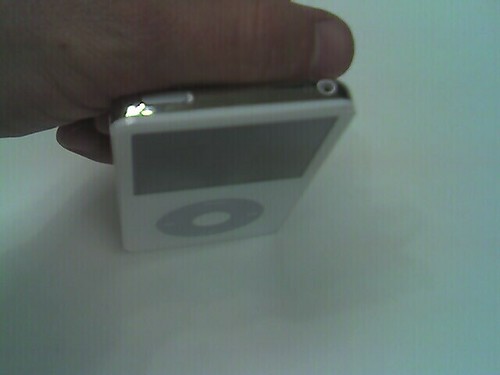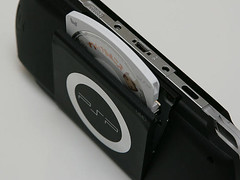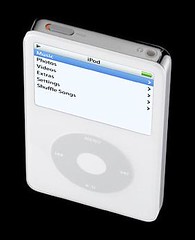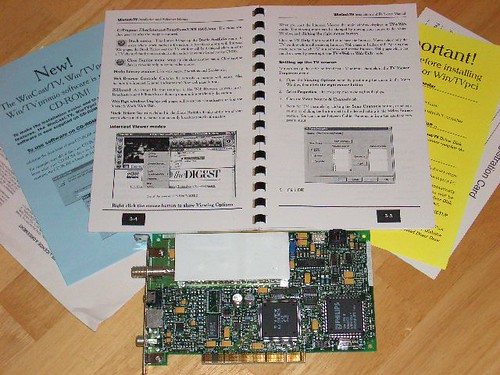We knew that Steve was going to do it, even when he said that people don't want to carry movies around with them. Apple announced their familiar form factor yet thined iPod with 30 frames per second video playback through its new 2.5 inch screen. It also supports a composite RCA output, which is unique over the PSP's closed video output architecture. Will iTunes content (which is weak with 2000 mostly unknown videos at launch) beat the Sony Connect service with its downloadable media and retail UMD movies? Time will tell, but we can dig into the technical specs right now between the two devices.
The iPod won the war of the pocket music players against Sony, the inventor of the portable music category, from their Walkman and Discman players in the 1980's. Apple beat them from their 30 year monopoly because the iPod supported 7 different compressed media formats versus Sony's single ATRAC codec, a carry over from their MiniDisc technology they pushed into their "MP3" player lineup. It was not until Fall of 2004 that Sony announced MP3 support, well after the device game was lost. In 2005, they began shipping laptops with SD and Memory Stick ports - a further shift towards supporting standards other than their own.
Lets look at the specifications of the Sony PSP vs. the iPod 5th generation video player.
Sony PSP:
Overall device size: 6.7 x 2.9 x .9 inches
Video formats via "UMD": H.264/MPEG-4 AVC Main Profile Level3
Video formats via "Memory Stick": MPEG-4 SP,AAC
Output via 4.3" 16:9 TFT
480 x 272 pixel, 16.77 million colors (130,560 pixels)
Content via Sony Connect or retail UMD movies
Create your own via Image Converter 2 Plus for $14.99
Storage capacity: 2GB or 10 hours via Memory Stick Duo or unlimited via UMD media
Battery: 2-3 Hours
iPod 5th Gen:
Overall device size: 4.1 x 2.4 x 0.43 inches
Video formats: H.264 video: up to 768 Kbps, 320 x 240, 30 frames per sec., Baseline Profile up to Level 1.3 with AAC-LC up to 160 Kbps, 48 Khz, stereo audio in .m4v, .mp4 and .mov file formats
MPEG-4 video: up to 2.5 mbps, 480 x 480, 30 frames per sec., Simple Profile with AAC-LC up to 160 Kbps, 48 Khz, stereo audio in .m4v, .mp4 and .mov file formats
Output via 2.5" 4:3 TFT and RCA Composite output
320 x 240 pixel 16.7 million colors (76,800 pixels)
Content via iTunes Music (and Video) store
Create your own via Quicktime 7 Pro for $29.99
Storage capacity: 60GB or 150 Hours of video (max)
Battery: 2-3 Hours
The iPod is clearly smaller, but the screen is nearly half the resolution of the PSP. Remove its wide screen capabilities and you are going to need to get your eyes close to the iPod to see detail in videos. There is a psychological difference to these devices too. The iPod is known as a "passive" listening device where the PSP is an "active" engaging product. We have to engage to watch TV or play games so the iPod's video capabilities may go forgotten after the novelty wears off or the time to download content into iTunes then transfer it from your computer to the iPod makes us weary. If users have large music collections, the tradoffs between many songs being replaced by only a handful of TV programs may be another detriment.
Sony has their Connect download service and many UMD movies in retail stores while Apple has no movie program because of digital rights issues from the DMCA and only a few "formerly free" broadcast TV programs and some music videos available to purchase. I predict that it is only a matter of time before Pixar and Disney movies are available on the iTunes service, with the other studios to follow. Downloading a 2+ hour movie will be extremely time consuming and expensive for both a time and cost of bandwidth standpoint.
Both Sony and Apple offer software programs to convert home movies or TV programs that reside on your PC hard drive into MPEG4 formats compatible with their devices. Unfortunately, as easy as it is to rip your audio CDs to MP3 format, neither of these will allow you to "rip" a DVD that you own onto the devices although third-party "hacks" will let you achieve this with a few extra steps.
Now Apple does support a TV output and even an optional $39 remote control which makes this a neat "pocket PVR" for your television at home or on the road. Today, at the launch of the 5th gen iPod, I say the PSP wins at video and the iPod wins at music. These tables could change however, if Apple buys TiVo and enables their PC Home Media Option or rear USB ports to sync between the two formerly disparaged devices. An iPod that "talks" to a TiVo would be one of the few killer convergence devices. If you think about it, both Apple and TiVo have nailed the perfect consumer experience. Sony is playing catch-up.
